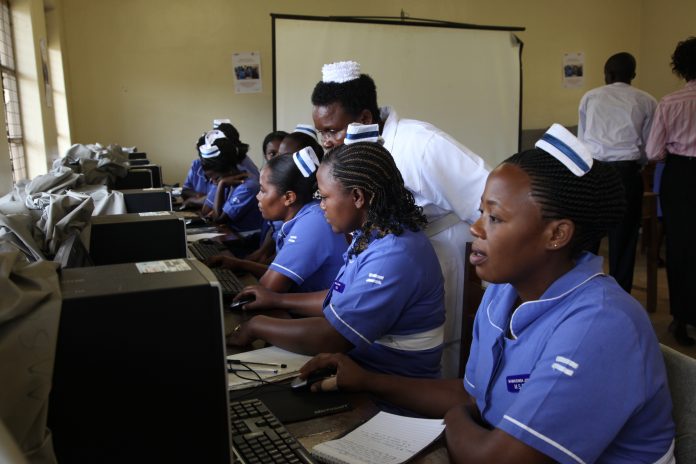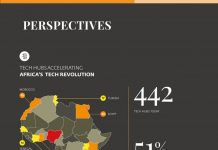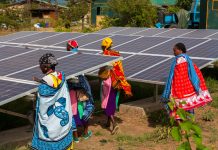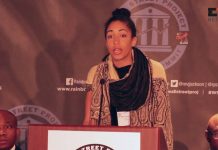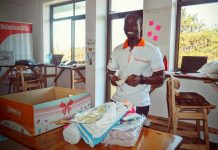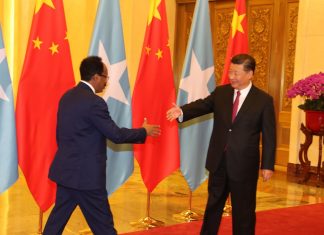Earlier this year I spoke with Peter Ngatia, director of capacity building at the Kenya-based African Medical and Research Foundation (AMREF), about his organization’s work. Ngatia is a 25-year AMREF veteran with a Ph.D in medical education, planning and development from the University of Alberta, Canada. He’s also the recipient of the Elder of the Order of the Burning Spear for outstanding and distinguished services in national and global health. That’s one of the highest civilian service awards granted by the President of Kenya. Ngatia spoke with me at AMREF’s New York offices when he was in the U.S. to meet with AMREF’s international board and U.S. partners. One of those partners, Accenture, a leading provider of management consulting, technology and outsourcing services, had recently awarded AMREF a $1.4 million grant to help Ngatia and his team develop their idea for a mobile health training program for community health workers. Our conversation is below.
AfricaStrictlyBusiness.com: What are the biggest challenges in African health care?
Ngatia: There are huge challenges in the health systems of Africa. The primary one is the shortage of health workers. Africa today has a shortage of about 800,000 health workers. These are needed between now and 2015. Africa bears the heaviest burden of disease. About 24 percent of the world’s disease burden is borne by Africa; yet, Africa only has about 3 percent of the world’s human resource, or health workers, population. Africa has only 1 percent of all the funding for health in the world. Putting all that together, it makes the African health system a very, very fragile health system from all angles. If you take human resources, there’s a huge deficit. If you take the supply of drugs, again, there are huge shortages of drugs.
You go to the health facilities and maybe there will be a low level cadre of health worker who will prescribe, and who have been trained by organizations such as AMREF. That’s what my job is — to look at meeting the gaps, because we can’t say we’ll wait to get this 800,000 of workers. So our strategy is to bring in those literate women, men, and youth that can be trained over a short period of time to get the basic, core skills.
AfricaStrictlyBusiness.com: How do you recruit these potential trainees? Where do you find them?
Ngatia: We work with communities. AMREF is known to work with communities because we believe that if you work with communities, then you’re going to cause lasting health change. So “community health workers,” as we call them, are selected by communities. They are people of opinion; they are people of good literacy and numeracy; and the communities trust them. We bring them on board and train them over a period of time to be able to, one, recognize simple common diseases; and two, recognize them for either treatment or referral.
In a country like Kenya, for every 50 households there is one community health worker. She is the one – I say ‘she’ because most of them are women – who will be called when a child has fever, or when an expecting mother needs to be delivered or to be taken to the hospital. They are the ones who are the doctors at that particular level of health care provision.
Distance, Leadership Management Challenges
Ngatia: The other huge problem is the health facilities are so far away. For every five kilometers radius, there should be a health facility. In Africa, it is 20 kilometers radius; if you are lucky, 10 kilometers radius. So you can imagine a mother who is in labor has to be taken twenty kilometers. And it is not New York. It is not Connecticut. It is a country without roads, and when they are there, they are potholed. There are no vehicles. There is nothing. So, the community health worker becomes very, very important in that situation. If one were to resolve the problem of bringing healthcare facilities closer to the people, I think a huge problem would be dealt with.
The other area that we as AMREF think is a huge problem is lack of leadership management of the health system.
Everybody has assumed over years that because Peter is a good doctor, he is therefore the right person to go and head the ministry of health; he is the right person to go and lead the national hospital. But Peter doesn’t even know how to make policies. He doesn’t know how to read policies, and he’s not very interested because he has specialized in cardio-thoracic surgery. You go to African ministries of health and the top man would be one of the high-level specialists, but they are sitting there signing checks.
So, what AMREF has done, with organizations like Johnson & Johnson, UCLA (University of California, Los Angeles), and JAICA (Japan International Cooperation Agency), is come up with programs for training health leadership – management, leadership and governance. So far with Johnson & Johnson I think we have created over 700 leaders, medical superintendents, in the ministry of health, or heads of rural health facilities…
AfricaStrictlyBusiness.com: This is training for administrative, policymaking roles, focused solely on health?
Ngatia: Yes. Training in planning, budgeting, basic skills, focused on health. But really there isn’t much difference because if you have an MBA you deal with the same issues of accounting, budgeting planning and all that. But we tweak our MBA.
AMREF has started an MBA in health. Since we are not a university we have joined with a university called the United States International University. They used to have campuses here in the U.S., in Kenya and in another country, then they separated. The campus that was in Kenya has now become an independent university. We have partnered with it and we are running an MBA in health to attract health workers and doctors, so that when they go back they know how to analyze policies, they know how to make policies, they make decisions on evidence. Those kinds of things are the ones that we are dealing with.
AfricaStrictlyBusiness.com: This is a unique program? There is no other like it?
Ngatia: Peter: This MBA in health is very unique. There is no other program like it anywhere in Africa. So I would summarize by saying that the challenges that I see are the shortage of human resources; I would say the huge distances where health facilities are located; the huge shortage of the essential medicines and drugs; and finally that lack of leadership and management.
Applying information technology
AfricaStrictlyBusiness.com: What about technology? There are these young whiz kids who are creating new technologies for mobile devices. Some are creating apps to transmit health information, especially from rural communities, to specialists, like the CardioPad where the healthcare worker administers tests and transmits the results electronically to the doctor who is far away. In your management training program, to what extent do you use technology?
Ngatia: Let me start by saying that AMREF has recognized that ICT is the tool of our times to deliver health. And we call it the tool of our times because AMREF started by looking at the tool of the time, when the airplane was the vehicle to deliver health to the most remote areas. That’s how we started. Our innovation has always looked at what it is that we can use to deliver health effectively to the communities, from the Flying Doctors to where we are today.
Telemedicine is part of what AMREF now does. What you are mentioning now we have done it for the last 10 years, where we have doctors who are, of course, in these urban areas and we have these low-level community health workers out there with their mobile phones, or, as some of them do have, their laptop or computer. They are able to talk to the doctor and say ‘here I have a mother, or a child, or a man with this problem.
My tests are showing, but I can’t figure out whether it is pneumonia or fever caused by another infection.’ And the doctor will look at that and will give the answer to this person.
There is even technology that AMREF has used lately, whereby you can take radiographs, chest X-rays, and actually post it to the doctor and the doctor, the radiologist, looks at it and tells you, ‘That is TB, start the following treatment straightaway.’
Testing e-learning
Ngatia: I talked about shortage of health workers. This has been an area of concern for AMREF for a long, long time. We looked at these 800,000 health workers. How can you ever reach those numbers by using the conventional methods of training, which require you to have a classroom, a dormitory and a number of teachers, because, if you are training nurses there is an issue of one teacher to 15 students? That is the ratio and it is an international standard.
So for you to have a class of 30, it means you have to have two tutors, and so on and so on. We don’t have this because the shortage is across the health system. So AMREF was commissioned by the minister of health, Kenya, to train 22,000 nurses, to upgrade 22,000 within a period of eight years. We were approached because we used to do correspondence courses for health workers. We started doing that for this project and then it hit us that that wouldn’t work. That’s when we applied e-learning.
So far, we have upgraded 15,000 nurses, and we are only in the sixth year. Many people had said you couldn’t teach a nurse using the computer because nursing is hands on. We have proven them wrong. We do not use an AMREF curriculum; we use the government curriculum. The Nursing Council of Kenya is the lay curator and our role is to teach using the computer. We set up the infrastructure. We set up computers in the hospitals. We set up computers in the health centers, and we set up computers in AMREF.
The AMREF school, we call it the AMREF Virtual Nursing School, was like a laboratory because e-learning wasn’t heard of. We didn’t know much about the use of e-learning. So we set up a school within AMREF to test the methodology. As we applied it, we were testing it. And so far, with those 15,000 that we have trained, the Nursing Council of Kenya has said this is the way to train nurses.
Nurses continue to train using the conventional method and the Nursing Council compares the performance on the exams – the exams are set by the Council, both the practical and theory – of the ones who are in the classroom with these ones who were taught by e-learning. There are papers now that have shown the performance of the e-learner, both at the exam level and at the job level, is far superior to the classroom one.
AfricaStrictlyBusiness.com: How do you get the equipment, the computers, for the e-learning program?
Ngatia: It requires lots of computers. We set up 34 centers around the country. The beauty of this is that the nurse does not leave her job. The arrangement with the supervisor is that she is given two hours every day to study. But she does not leave her job like the one who is in school, who leaves for eighteen months. I talked about shortage of health workers – if you take her away you leave nobody. So you are causing even a bigger problem. But with the e-learning, they were there, except for the two hours. They were not taken away from their families, and their performance was as good.
The computers, the laptops, are bought by the project. AMREF – I said we were paid –included all that in the calculations. We made arrangements with suppliers of second-hand computers who supplied us with lots and lots of computers. If you go to the hospitals in Kenya today there are computers, I mean in learning centers, everywhere. We have now moved from upgrading – from the nursing certificate to diploma, from diploma now to a bachelor of science in nursing. We have collaborated with the University of Nairobi because, again, we are not a degree-offering institution. With the University of Nairobi, we have upgraded the e-learning program to a Bs.N.
So ICT use, yes. We haven’t moved from the computer, but we have now realized that there is a device called the mobile phone. The mobile phone in Africa is omnipresent. We didn’t believe it, so we did a study with the community health workers. Community health workers, as I said, are community people, village people – not well off. If they have a phone, they have a very basic phone. Not smartphones. And we came up with an idea: how can we use the simple mobile phone to train community health workers?
We did the study I was talking about and we found that in the population of community health workers, seventy percent had a mobile phone. Seventy percent had a basic mobile phone. Basic. Ninety-eight percent have a phone. So we said, ‘Hey! This is the tool of our times. Let’s see how we can use it.’ The difficulty of course is, with a smartphone you can do anything, with a basic phone you have to figure out how to use it. So we entered into a consortium with Accenture, Mpesa, Vodafone and a company called Safaricom in Kenya, and for the last three months we have tested our mobile phone with the community health worker using interactive voice, SMS, and another technology. We found that you can actually teach a whole lesson.
The CEO of Safaricom could not believe that this can be done. Since they are paying he asked that we take these community health workers who have done it for three months for a demonstration. He was amazed at what he saw. We are able to teach full lessons; we are able to examine them; we are able to give them more materials. A big problem with the factual level of education is that they do not have all of the information at a go. So you have to keep on giving them more references for whatever they are doing.
And we have come up with what we call in medicine the diagnostic trees. In a diagnostic tree, we will say ‘this mother has come, the child has a fever of that; do this, do that,’ and so on until we get to the diagnosis. We have been able to put those trees in the phones and now the health worker will just look at this and say, ‘that kid has pneumonia.’ That was the most impressive bit of it, that now they are as accurate as they could ever be with the diagnosis.
AfricaStrictlyBusiness.com: How do the health workers access the information via phone? Do they have to pay?
Ngatia: Those that are being trained are not paying because it is a project. But they will have to pay in the future. But again, they are being trained by government, so what we have done is help government cut the cost of the training. It used to be $600 to train a community health worker. We have cut it to $250 using the mobile phone and I think we shall go lower than that when we have the numbers, many health workers, because Kenya would like to train about 200,000.
For the whole of Africa, the Africa Union wants to train one million. If this platform – we call it H.E.L.P., Health Enablement Learning Platform –is adopted and the AU, for instance, wants to use it, we shall have huge numbers and therefore. The more people we have using it, the lower the cost will be. We can even negotiate with Safaricom and say, “hey, 200,00 health workers? For every messaging we shall only pay you not 4 shillings they are charging us now, but two shillings.” The volume will dictate the price.
Replication
AfricaStrictlyBusiness.com: All of these ideas, where are they coming from?
Ngatia. I personally am fascinated by technology. I sit down and I think. I have a team that looks at it. There is one girl, Caroline. I will come up with an idea and Caroline will tell me how we can do it. So it is a very small team, but when we come up with an idea, Accenture, of course, will run to it because the future is what they are looking for. They are going to probably make huge profits [with the technology] in health, but they looking for even bigger applications – through the Coca-Colas, with the Army, with everybody, because they have a bigger reach than we have. So they run to us to help us test it.
AfricaStrictlyBusiness.com: Do you patent your applications?
Ngatia: Yes. This is the first time we have patented the intellectual property. This time it is going to be AMREF. But when we did the e-learning, Accenture took it all. For 25 years.
AfricaStrictlyBusiness.com: So now you know better.
Ngatia: It took us six months of negotiation. We hired lawyers. We are a small organization. We don’t even have a lawyer in house. At the bottom of the pit, if you are right in there, they do anything to you. So this time we got pro bono lawyers from the UK and now we have the rights.
AfricaStrictlyBusiness.com: A lot of this is focused now in Kenya. Will there be replication in other countries?
Ngatia: Yes, replication is going to happen. It has started happening with e-learning. We are training midwives and nurses in Uganda using the e-learning methodology. We are in Malawi, we are in Tanzania, we are in Senegal, and I think sooner or later we shall be in the 55 states of Africa.
Networking medical schools
AfricaStrictlyBusiness.com: You said you’re partnering with Nairobi University in e-learning, but for the kind of work you’re doing, do you have any partnerships outside Kenya, with African medical universities?
Ngatia: In leadership and management, we have partnered with 33 universities, institutions of higher learning, across Africa. And the way we did it was to come up with a network we call the Africa Health Leadership and Management Network, AHLMN. The purpose of AHLMN is to network all institutions that teach leadership management and governance in health or would like to teach – most of them is ‘would like.’ This network is housed in AMREF, but it has a French wing in Dakar, Senegal. It takes care of francophone Africa. Nairobi takes care of English-speaking Africa. Maputo in Mozambique takes of the lusophone Africa.
So this network has got wings all over the continent. The universities, medial schools, and even schools of public health now interlink with the AHLMN.
The Next Step
AfricaStrictlyBusiness.com: What’s Next for AMREF? Where would you like to be five years from now?
Ngatia: You have heard that every time I want to develop a great idea, I have to have collaboration with a university. My next idea is to have the AMREF International University, which will be the seat of public health and community health in Africa. We want to develop a portal, if you like, where, if you are at Harvard and you want to know things on public health and community health in Africa, your first port of call will be AMREF. If you are in Africa and you want to know what is happening in public health and community health in Africa apart from your country, your port of call will be AMREF. And if you are in Africa and you want to know what is happening with health care, Obamacare, in the United States, your port of call will be AMREF. That’s our vision.
AfricaStrictlyBusiness.com: And you’ve started working on that vision?
Ngatia: Oh, yes! I present a paper on Wednesday next week to the AMREF international board.
AfricaStrictlyBusiness.com: You’ve given yourself a timeline to establish this AMREF university?
Ngatia: Yes, three years. By 2016, we will have what we call a constituent college – we’ll be attached to a medical school in Nairobi, and by 2018, we become a full-fledged university.
AfricaStrictlyBusiness.com: I am so glad that you’re tech-oriented because Kenya is one of the continent’s biggest hubs of technology, the brain pool of mobile technology.
Ngatia: Mobile, e-learning, telemedicine. These are the big things that are going to support the health system in Africa. And for the ideas that I am talking about, we are targeting the whole of sub-Saharan Africa, not just Kenya. We start in Kenya because that’s where AMREF was founded and is headquartered. So the big ideas are sort of formed out of there and then they are replicated across the continent.
AfricaStrictlyBusiness.com: And your partnership with Johnson & Johnson on the MBA in health, that’s in cement?
Ngatia: Yes. That one has been there since 2006. In fact, we are coming to New Brunswick to look at the future and the future is to see how best we can spread it. I think right now we are running it in three institutions – in Nairobi, in Cape Town at the University of Cape Town, and in Ghana at Gima, the Government Institute of Management.
We want to see how can we now touch beyond West Africa. When we put things in Ghana, you are only talking about the English-speaking West Africa. So we are looking at how we can integrate francophone Africa. Later on, we think the Arabic Africa will definitely be part of this. They look like they are doing better but in my contact with Sudan you see they are way, way behind. Even Egypt, some areas are still backward. Of course, those countries out there, like Morocco, are doing very well. Libya I don’t think is doing very well. It’s a matter of time. Even when Qaddafi was there they had the money, but what they never bothered to do is to have the human capital. I think that was neglected also.


